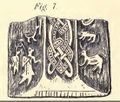Coats (Men)
From The Viking Age Compendium
| Coats (Men) |
|---|
|
More Men's Clothing pages
Wrap around coat (Warrior Coat)
Art
- Pre Viking Age
- Sutton Hoo helmet plates 600-625AD?
- Vendel Helmet plates 600-750AD?
- Guldgubber 550-800AD
Literature
--
Archaeology
- Hedeby Harbour, Germany (9th-11th C): Multiple fragments were found that Hagg interprets to be from wrap around coats (Klappenrock).
- Fragment 11: This fragment is of natural brown 2/2 twill and forms the bottom part of the right, front flap of a wrap around coat. On the reverse of the fragment there are remnants of the lining, made up from three different bits of cloth of differing weave and colour, and was probably made from parts of old, discarded clothing. [HAGG 1984]:p.73
- Fragment 76: This is another fragment from the front of a coat similar to Frag. 11. Small particles of copper alloy were found in one area of the coat, probably from a belt. Hagg thinks this fragment may have been the lining of a coat. [HAGG 1984]:p.83
- Fragment 19: This is a smaller fragment probably from the edge of the coat with an edge of piled fabric with long tuffts (2-3cm). [HAGG 1984]:p.76
- Fragment45A-B:
- Birka, Sweden: Ring pins were found at the right hip in four graves (BJ 1057, 471, 750, 643) In grave 976 the pin was at the left hip. Though whether these fastned wrap around coats, cloaks or anothe garment is unknown. [THUNMARK-NYLEN 1984]:p.11
- Pre Viking Age
- England, Taplow.
- England, Castledyke. Grave 126. Strip of tablet weave running vertically. Identified by Penelope Walton Rogers as a wrap-over coat. [OWEN-CROCKER 2004]:p.181
- Germany, Cologne, Severinus. 'Minstrel's Grave' [OWEN-CROCKER 2004]:p.181
Discussion
--
Buttoned Coat (Kaftan)
Art
- Isle of Man, Jurby. Odin Stone 125(98).
- Sweden (Skane). Hunnestad Monument DR282.
Literature
--
Archaeology
- Ireland, Dunmore Cave. Fragments of patterned silk and 16 button-like silver objects in 3 different sizes. [EWING 2007]:p.109. Ewing points out that these objects may have been purely ornamental
- Birka, Sweden: 5 graves (BJ 716, 752, 944, 985, 1074) contained buttons from a kaftan style coat. The buttons are of copper alloy, except for BJ 985 where they are lead. The buttons run from the neck to the waist, and not further [HAGG 1986]:p.68. In two of the graves (BJ 716, 1074) the coat was worn with a studded belt of eastern type. [JANSSON 1986]:p.92 A third grave (BJ 752) was also found with a buckle.
- BJ 716, 8 copper alloy buttons, studded belt, penannular, bag. Online
- BJ 752, 10 copper alloy buttons, buckle from a belt
- BJ 944, 7 copper alloy buttons, weapon knife and sheath, comb, shield, sword and scabbard, penannular, etc Online
- BJ 985, 4 lead buttons, thor's hammer ring, spear, shield, knofe, comb, etc Online
- BJ 1074, 18 copper alloy buttons, studded belt, spear, knife, comb, etc Online
Discussion
--
Body Warmmer (Thorax)
A waist length wrap around garment or fur or wool with either short or no sleeves
Art
- Louis the Pious (AD826) [EWING 2007]:p.115
- Fuller brooch (late C9th)
Literature
- Einhard: Life of Charlemagne (c.AD829-836) in winter by a close-fitting coat of otter or marten skins. [OWEN-CROCKER 2004]:p.174 [EWING 2007]:110-112
- Ólpa, stakkr, kufl: Norse for clothing made out of shaggy felt or fur [HAGG 1984]:p.186.
Archaeology
- Hedeby, Denmark (late C10th – early C11th) 9 fragments of heavy fluffy woollen (5mm thick) body warmers [HAGG 1984]:p.183-185 cut to wrap around the front of the body and to reach to just below the waist. One of the Hedeby finds had a trace of bronze near the bottom corner probably from a bronze pin [EWING 2007]:p.111
- Cumwhitton, England (AD900-950) A possible sealskin thorax [PATERSON 2014]:p.76
Discussion
Geijer translates Einhard’s description as a ‘waist coat’ [GEIJER 1938]:p.148
Hagg puts forward a theory that the woollen finds from Hedeby would have been worn by normal people as an affordable version of the fur body warmers worn by the rich [HAGG 1984]:p.183-185
Ewing describes Einhard’s garment as “this garment covered just the chest and shoulders; the kings thorax is of otters kin or ermine and he wears it for warmth” [EWING 2007]:p.110-111
Reference
Geijer, Agnes (1938) Birka III - Die Textilfunde Aus den Grabern. [The Textile finds from the Graves] Birka, Kungliga Vitterhets Historie och Antikvitets Akademien [GEIJER 1938] ^ *
Hagg, Inga (1984) Die Textilfunde aus dem Hafen von Haithabu. [The Textile Finds from the Port of Hedeby]. Hedeby-Ausgrabungen in Haithabu [HAGG 1984] ^ 1 2 3 4 5 6 *
Hagg, Inga (1986) 'Die Tracht'. In Arwidsson, Greta (ed.) (1986) Birka II:2 Systematische Analysen der Graberfunde. [Systematic Analysis of the Graves Findings] Birka, Kungliga Vitterhets Historie och Antikvitets Akademien: II:2 [HAGG 1986] ^ *
Jansson, Ingmar (1986) 'Guertel und Guertelzubehoer vom Orientalischen Typ'. In Arwidsson, Greta (ed.) (1986) Birka II:2 Systematische Analysen der Graberfunde. [Systematic Analysis of the Graves Findings] Birka, Kungliga Vitterhets Historie och Antikvitets Akademien: II:2 [JANSSON 1986] ^ *
Owen-Crocker, Gale R. (2004) Dress in Anglo-Saxon England. 2nd ed. The Boydell Press. [OWEN-CROCKER 2004] ^ 1 2 3 *

